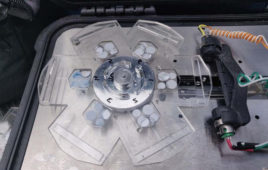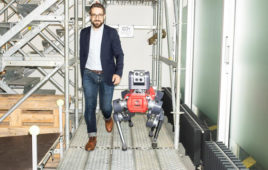The Radiology department at the University Hospital of Basel has state-of-the-art equipment. In addition to the world’s first 3D X-ray device, the hospital also relies on a new laser navigation system for CT scanning – guided minimally invasive surgery. “It offers a lot of advantages for image-guided operations,” explains Dr. Christoph Zech, head of the Interventional Radiology department at the University Hospital of Basel.
Visualizing the invisible
 Since 1974, CT scans have been used to create detailed cross-sectional X-ray images of the human body. Doctors use these high-resolution images in their decision making, e.g., on where to take a tumor sample. But how do they reach that target? Where exactly do they place the needle tip, and what is the correct angle? Until now, this used to be a difficult challenge – every millimeter counts. Here’s where the fully automated laser navigation system made by the company amedo comes in. The device consists of a ceiling-mounted, arc-shaped rail on which a motorized laser positioning unit is mounted. That’s all – a simple system that makes a big difference for doctors and patients alike.
Since 1974, CT scans have been used to create detailed cross-sectional X-ray images of the human body. Doctors use these high-resolution images in their decision making, e.g., on where to take a tumor sample. But how do they reach that target? Where exactly do they place the needle tip, and what is the correct angle? Until now, this used to be a difficult challenge – every millimeter counts. Here’s where the fully automated laser navigation system made by the company amedo comes in. The device consists of a ceiling-mounted, arc-shaped rail on which a motorized laser positioning unit is mounted. That’s all – a simple system that makes a big difference for doctors and patients alike.
Lower radiation exposure
The navigation system uses a laser beam to project the needle’s point of entry on the patient’s skin and visualize the needle path along which the radiologist needs to move the instrument. Dr. Zech uses a foot switch to adjust the exact position of the needle. This triggers an imaging sequence to monitor the ongoing operation, the infiltration of a nerve root. The monitor of the CT scanner shows the position of the 0.7-millimeter-thin needle. It is already in the correct position in the first set of frames. “Here’s where the new laser navigation system is extremely helpful,” says Zech. The intrusion depth of the needle is also displayed. Additional CT scans to determine the position are hardly necessary any longer, which significantly reduces the radiation exposure for the patient. With traditional technology, the position of the needle had to be checked at least two or three times.
Read more in the latest issue of „driven“.
Filed Under: maxon Driven




